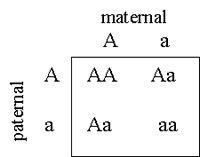

The Punnett square
Recall that in diploid organisms, each parent generates 2 gametes; the progeny inherits one from each parent. There are 4 possible combinations of the parental gametes that can occur in the progeny. A common way to visualize this is the Punnett square. Below is an example of a monohybrid cross, e.g. one trait or locus, with 2 diploid heterozygous parents.

One quarter of the progeny of this cross would be AA for this locus, one quarter would be aa and one-half would be Aa, giving a genotypic ratio of 1:2:1 (1 AA: 2 Aa: 1 Aa).
The Punnett square is a useful method to calculate expected ratios of genotypes and phenotypes; the next slide uses it to explain independent assortment.
For more detail, see: http://en.wikipedia.org/wiki/Punnett_square

